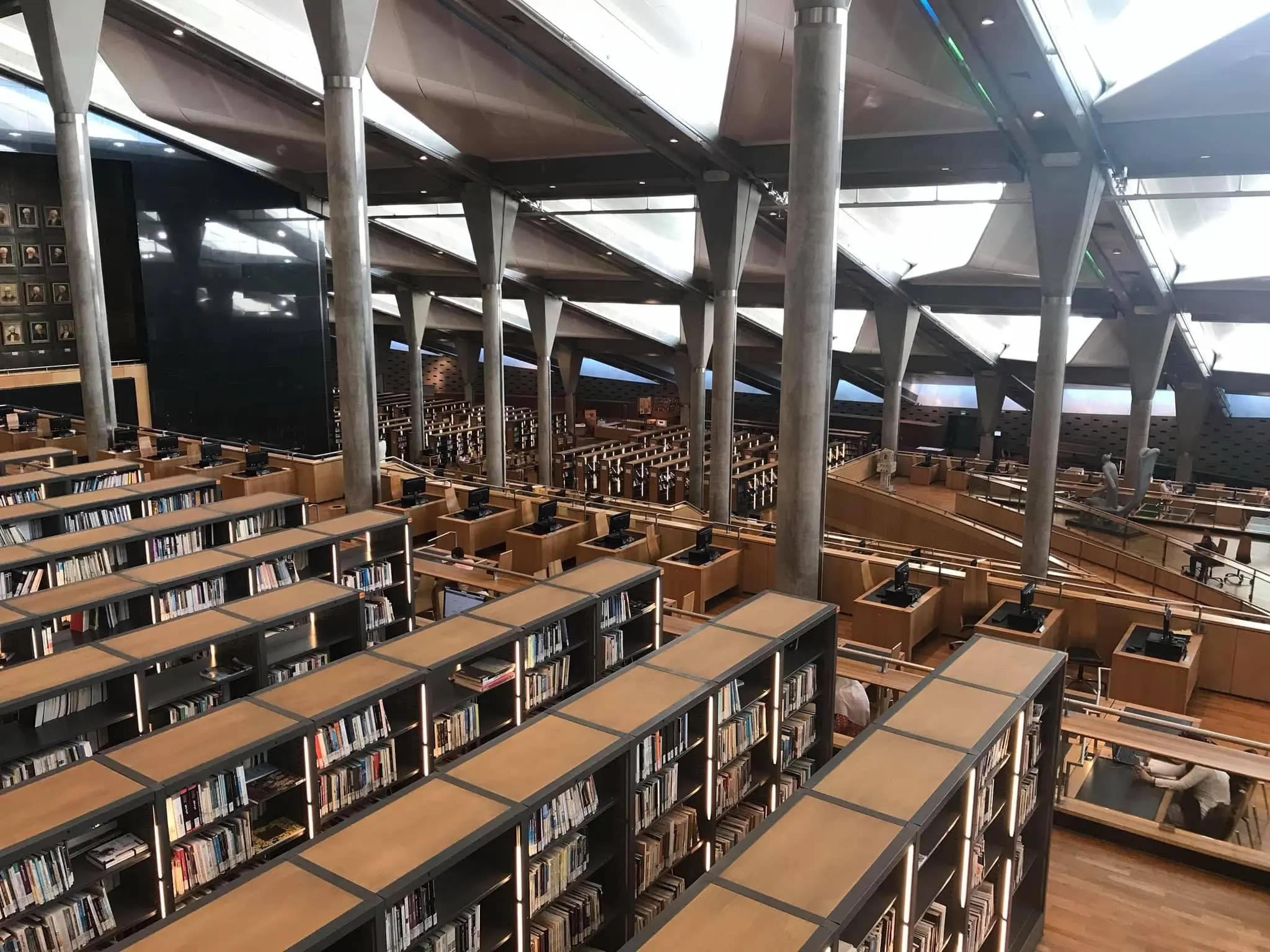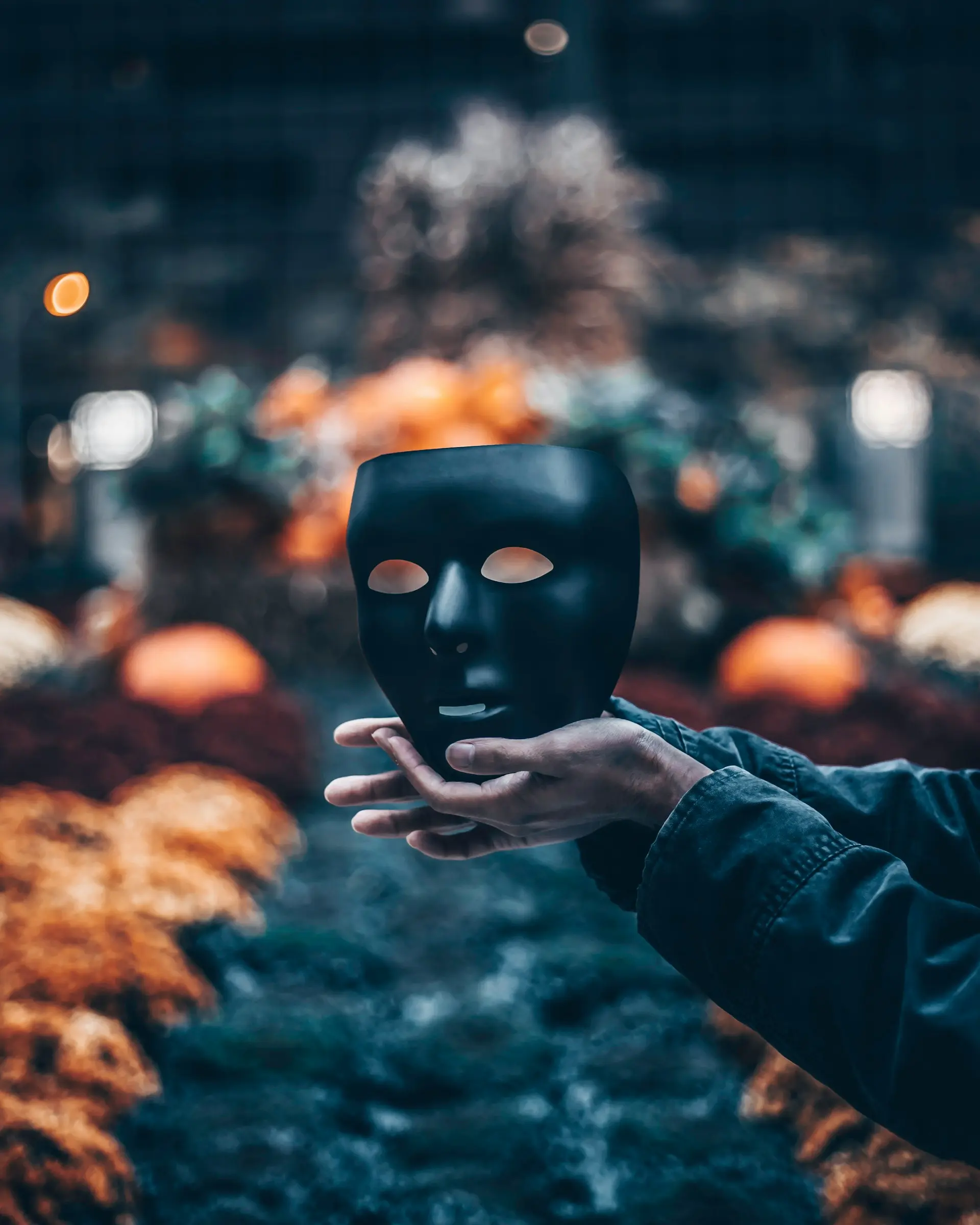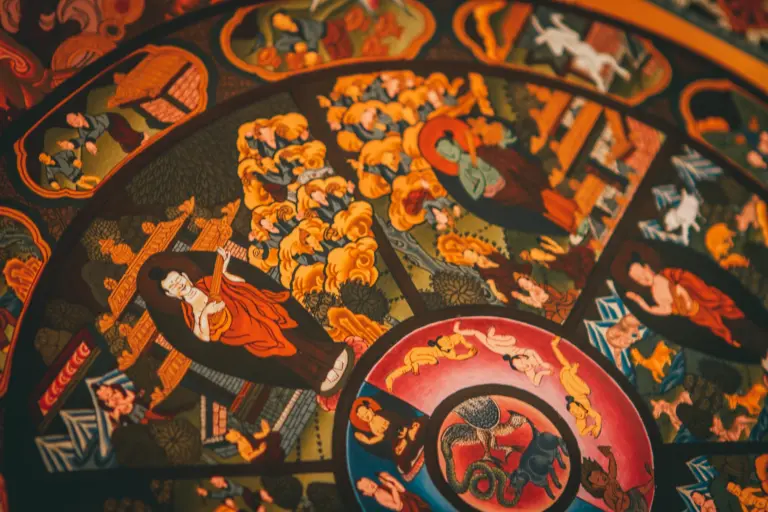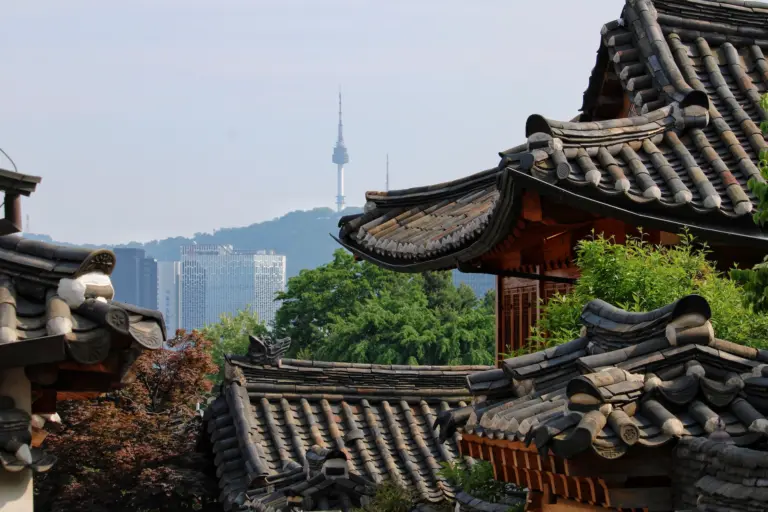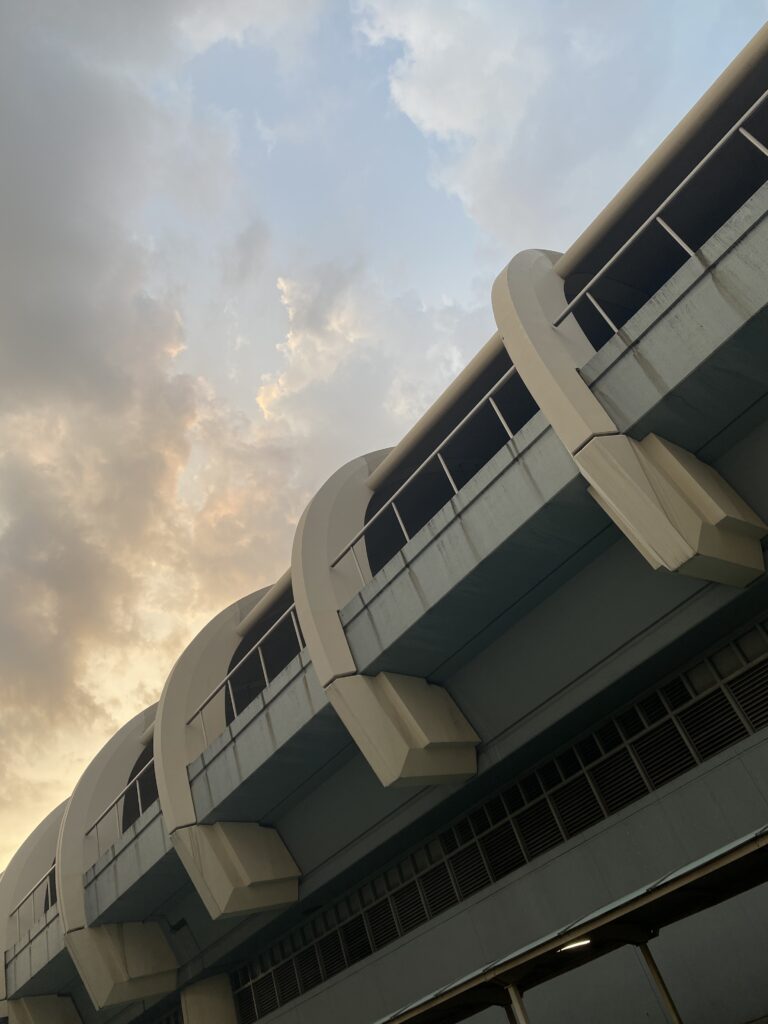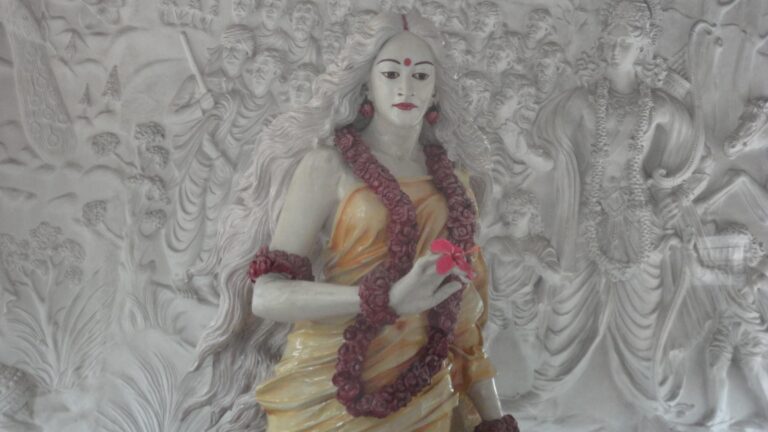In the windswept remnants of the ancient city of Karakorum, lies the mystical Erdene Zuu Monastery.
As one of Mongolia‘s oldest Buddhist monasteries, Erdene Zuu represents the profound spiritual heritage of a nation, weaved together in faith and stone.
Amidst the ruins of what was once the flourishing capital of the Mongol Empire, the monastery survived centuries of change, including periods of prosperity and suppression. In fact, Erdene Zuu Monastery was constructed from the very stones that bore witness to the rise and fall of Karakorum, linking Mongolia’s Buddhist traditions directly to its imperial past!
Today, its location near the ancient capital invites you to step back in time and walk once again through Mongolia’s great spiritual history.
Table of Contents
Toggle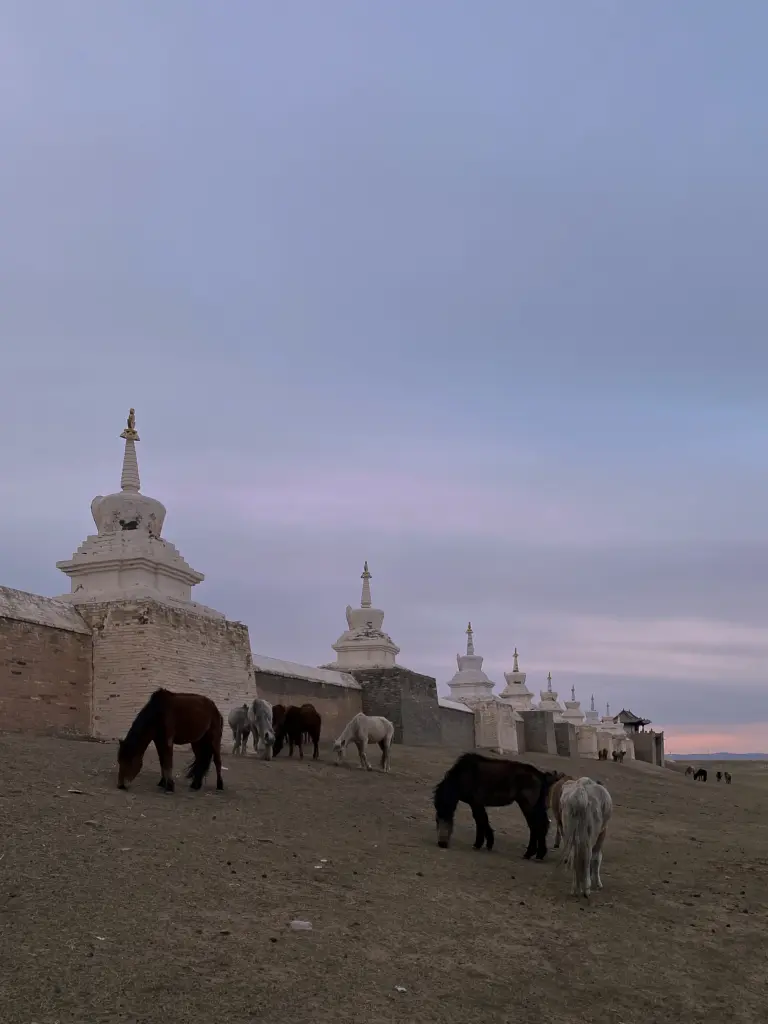
History of Erdene Zuu Monastery
Founded in 1586 by Abtai Sain Khan on the ruins of Karakorum, the ancient capital of the Mongol Empire established by Genghis Khan, Erdene Zuu signifies the intertwined destinies of Mongolian Buddhism and its imperial legacy.
Abtai Sain Khan, inspired by the introduction of Tibetan Buddhism (Vajrayana Buddhism) into Mongolia, envisioned the monastery as a spiritual center that would anchor the faith within the nation.
In the centuries that followed its establishment, Erdene Zuu Monastery grew to become one of the most significant Buddhist monastic complexes in Mongolia.
At its zenith, the monastery housed over a thousand monks and was a bustling center of religious scholarship, art, and culture.
However, the monastery’s prosperity was not to endure unchallenged. It was the 20th century that posed the gravest threat to Erdene Zuu’s survival. The rise of communism in Mongolia led to stringent anti-religious policies.
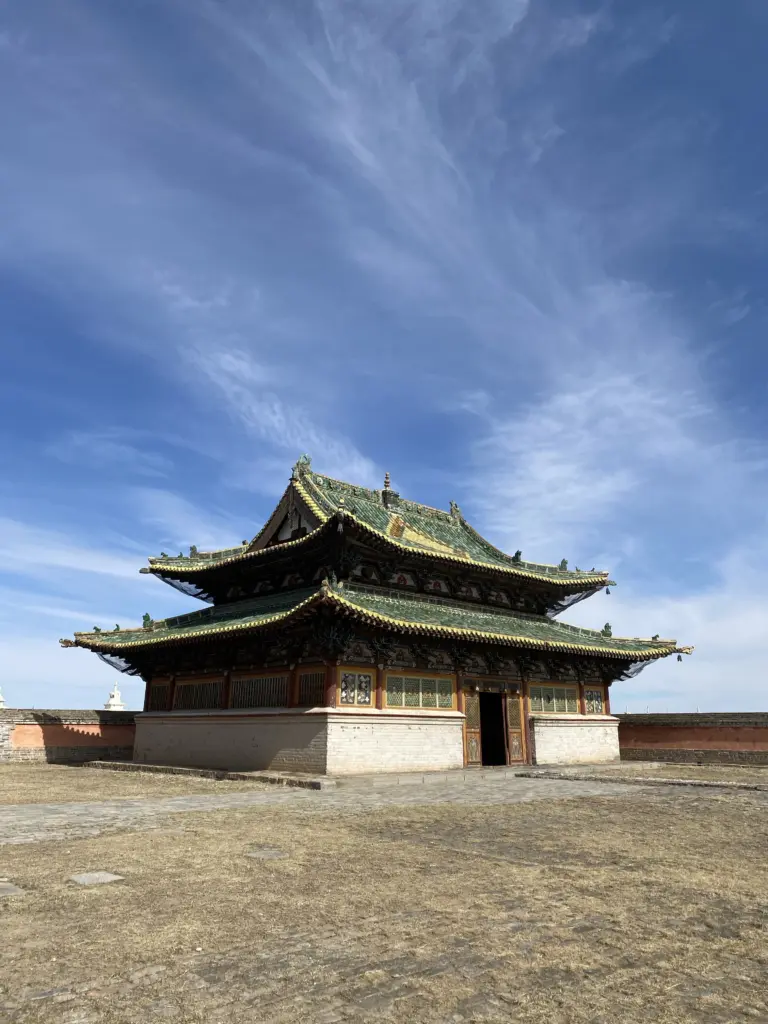
In the 1930s, the communist regime launched a brutal campaign against Buddhism, leading to the destruction of many monasteries across the country and the execution of thousands of monks. Erdene Zuu itself was closed, its treasures looted, and its monks persecuted.
Despite these dark times, the monastery endured. While many of its buildings were destroyed, a portion of Erdene Zuu was preserved as a museum, a decision that likely saved it from complete annihilation.
With the democratic revolution in Mongolia in 1990, Erdene Zuu Monastery experienced a rebirth.
The end of religious suppression allowed for the resurgence of Buddhism, and the monastery once again became a place of worship and spiritual learning.
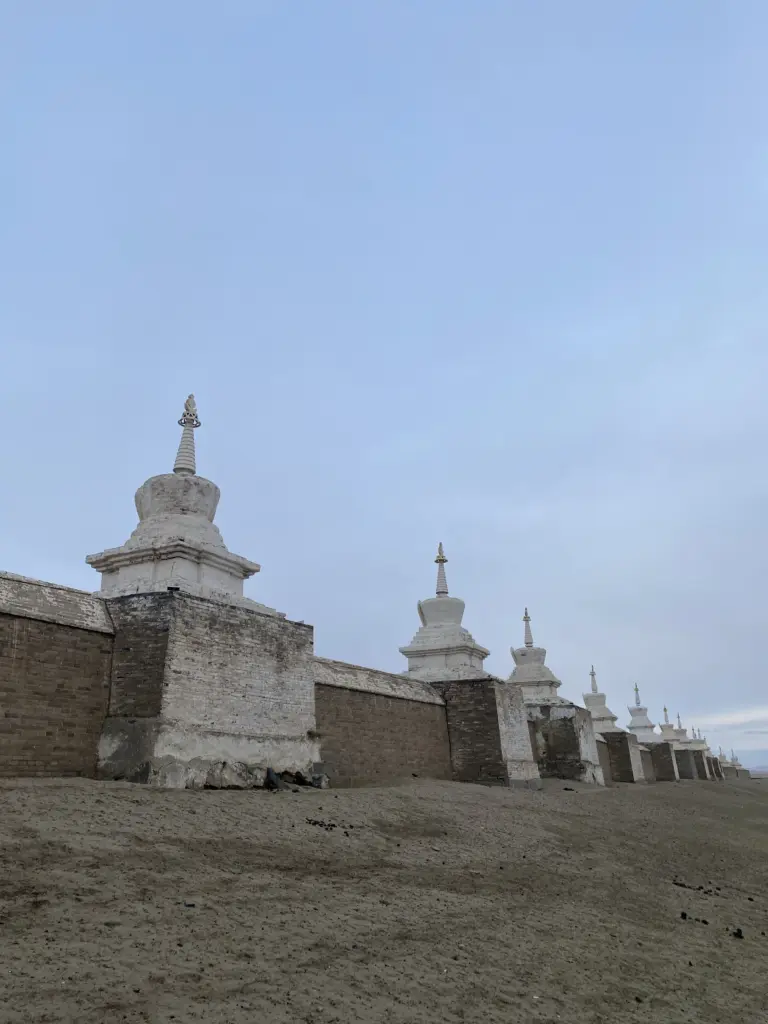
Architecture & Layout of Erdene Zuu Monastery
The monastery’s design reflects both the aesthetic traditions of Mongolian and Tibetan Buddhism and the deep symbolic meanings embedded in its structures:
- Walls and Stupas: Encircling the monastery is an impressive perimeter wall, punctuated by 108 stupas, a number of great significance in Buddhism representing the 108 volumes of the Kangyur, the teachings of Buddha. This formidable yet sacred boundary not only serves to demarcate the sacred space of the monastery but also acts as a meditative path for pilgrims. The stupas, with their white bases and conical spires, are a striking feature against the vast landscape.
- Three Main Temples: At the heart of Erdene Zuu Monastery are three temples, consecutively dedicated to the three stages of Buddha’s life: birth, enlightenment, and parinirvana (death).
- The Birth Temple celebrates the beginning of Buddha’s earthly journey.
- The Enlightenment Temple commemorates Buddha’s attainment of enlightenment under the Bodhi tree.
- The Parinirvana Temple is dedicated to the final stage of Buddha’s life, his death, and entry into nirvana, symbolizing the ultimate goal of liberation from the cycle of birth and rebirth.
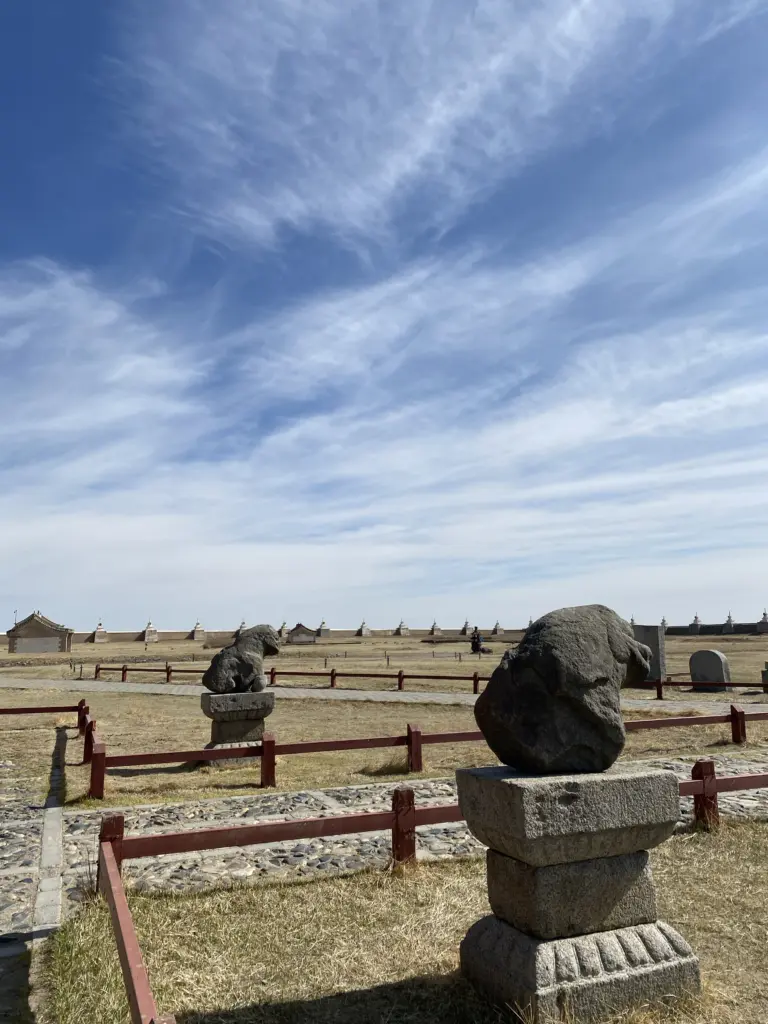
Best Time to Visit Erdene Zuu Monastery
The ideal time to visit Erdene Zuu Monastery is during the late spring to early autumn months, from May through September, when Mongolia enjoys its most temperate and accessible weather conditions.
In late spring, from May to June, the climate starts to warm, with daytime temperatures ranging approximately from 10°C to 20°C (50°F to 68°F).
As summer progresses into July and August, temperatures can climb to between 20°C and 30°C (68°F to 86°F), offering warm, sunny days ideal for longer visits to the monastery and the nearby ancient capital ruins of Karakorum. The warmer weather also coincides with several cultural festivals in Mongolia.
Early autumn, particularly September, sees a slight dip in temperatures, mirroring the conditions of late spring, with averages once again between 10°C and 20°C (50°F to 68°F).
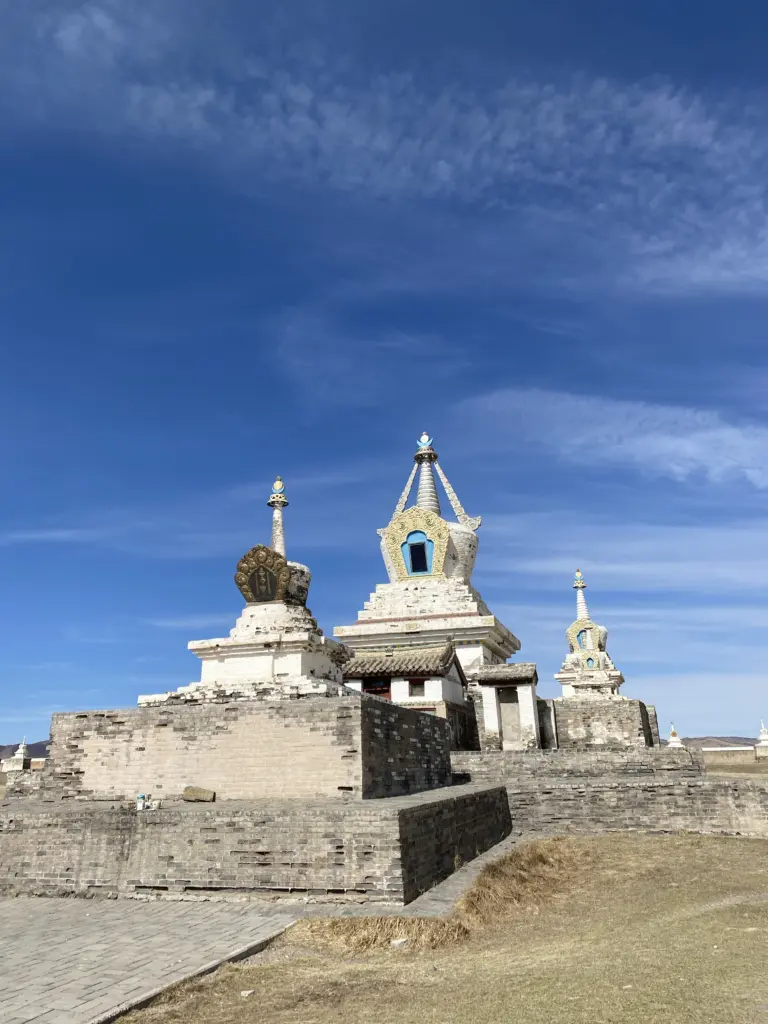
What to Expect when Visiting Erdene Zuu Monastery
- Entrance to the temple grounds is free but it’ll cost around 5,000 MNT to enter the individual temples. This is most likely already included in your tour package unless you are coming here alone from Ulaanbaatar.
- Erdene Zuu Monastery was part of our 3-day Orkhon Valley tour that we booked with UB Guesthouse if you’re interested. It includes Orkhon Waterfall and Hustai National Park.
- After you’re done visiting Erdene Zuu, make sure to drop by the Karakorum Museum to get even more insights about the history of the ancient capital. You might be surprised at just how progressive the Mongolian Empire was back then.
- You’ll most likely be staying in very good lodging while you’re in this area, it’s not likely you will be staying with the nomads as Karakorum has pretty good tourist infrastructure due to its proximity to Erdene Zuu.
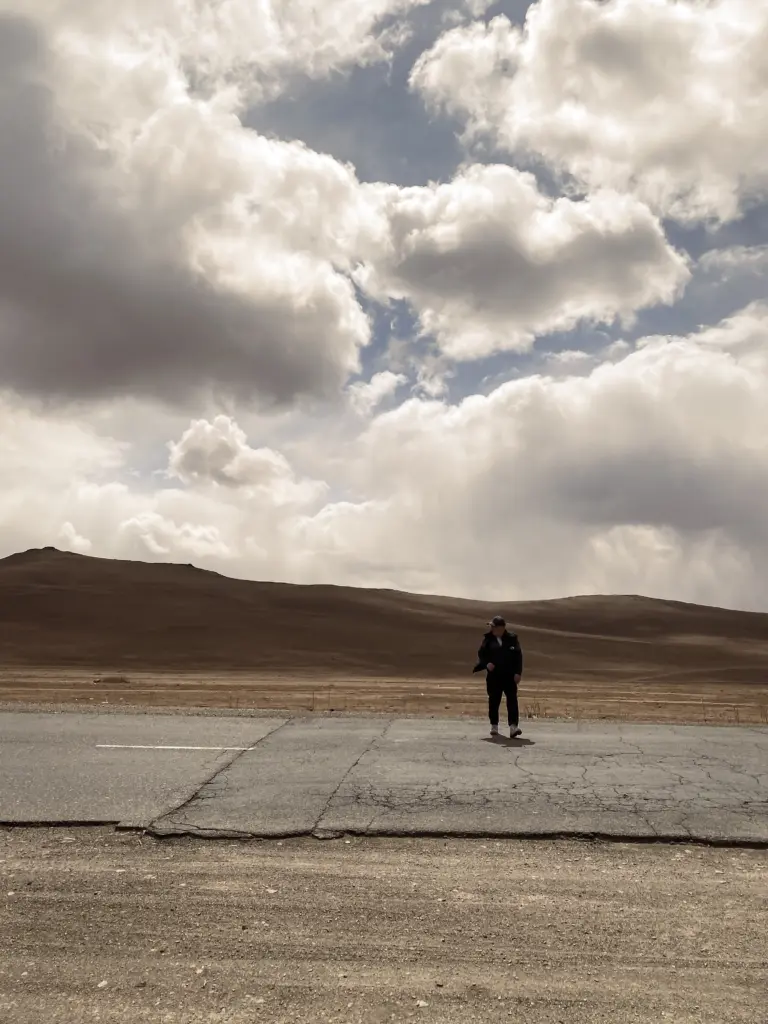
Our Journey to Erdene Zuu Monastery
Finally, my Mongolia adventure was about to begin. It was my first time to go outside the city of Ulaanbaatar. We first stopped by the supermarket to buy some stuff for the journey ahead such as snacks and water.
We were accompanied by our driver, Gana, a kind-hearted old man who smoked a lot of cigarettes.
Most of the trips in Mongolia, you’re stuck in the car for more than 5 hours or so but the beautiful countryside more than makes up for it. The terrain drastically changes every half hour or so, I was never once bored of staring outside the window.
It was only Emily and me for this trip so we had ample space in the car to put our legs up and we already had good vibes after last night’s karaoke session. We stopped by a makeshift stupa, stones put on top of each other in the shape of a dome with a flag structure on top of it with prayer flags flapping in the wind. We also stopped to take some photos of camels.

Our journey took the better part of the day and we arrived in Karakorum, the ancient capital, close to sunset. We were staying in quite a fancy hotel today, with beds better than the guesthouse and with a shower and toilet. Something we would soon be missing as we transition to living with the nomads in their ger.
Emily and I decided to brave the cold as the sun set behind over some clouds and do a lap around Erdene Zuu’s wall of stupas. It was quite worth it as we were pleasantly surprised with a herd of horses grazing behind the outermost wall. The sunset was turning a bit of pink as well though it doesn’t seem like the clouds were cooperative today. We talked about the Ramayana as we walked back towards our hotel.
The next day, Emily and I decided to go on another little morning walk in freezing cold. It was a silent walk though the frost but it was really grounding and the entire ordeal was very meditative. We went to the opposite direction today instead, towards the mountains instead of the temple. After a long walk back, we had breakfast with Gana before he took us to the temple complex.
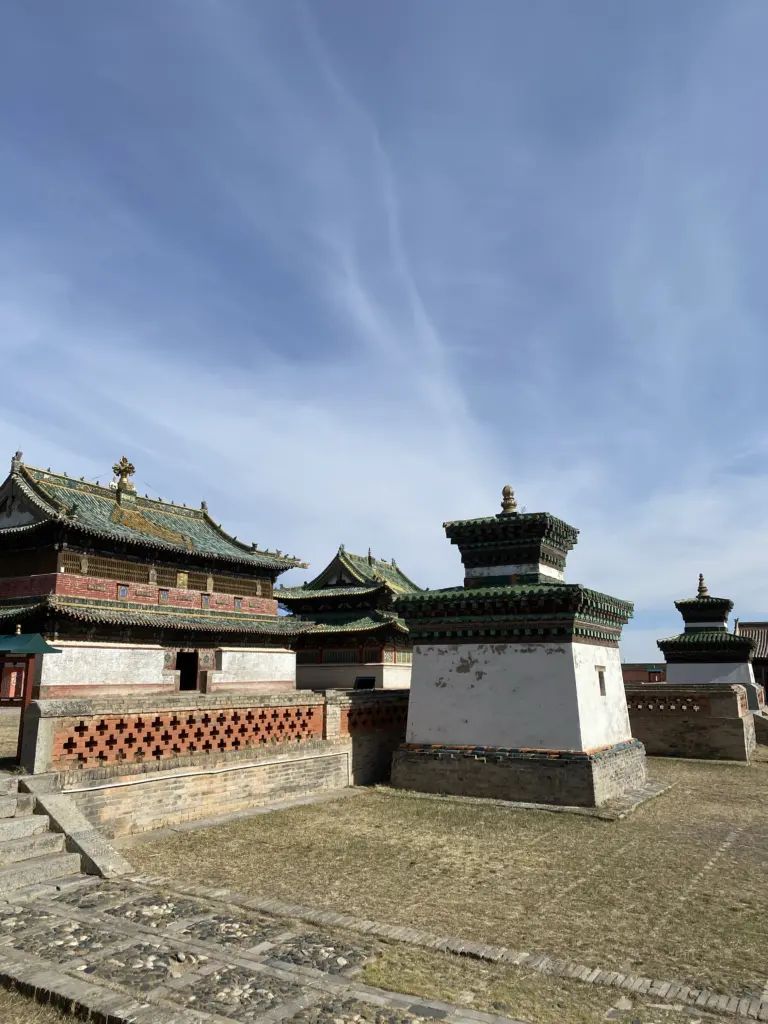
The weather was fantastic today, with blue skies which made the cold temperature much more bearable as we explored the huge expanse of Erdene Zuu Monastery.
It stretched as far as the eye could see with four walls surrounding it. The side temples were really intricate and featured various artworks of Buddhist Bodhisattvas, deities and cosmology. The 3 main temples were also pretty unique as it featured Shakyamuni Buddha in 3 stages of his life, young, present and old. Something I’ve never seen before.
We also went to the Karakorum Musem which had a nice virtual video of one of the aristocrat’s tomb and also featured a recreation of the old capital. I was quite surprised to find out just how progressive Chinggis Khan was as they had allowed Islam and Christianity to co-exist inside the main city.
Leaving Karakorum behind, we had lunch at a village where there were some school kids who we tried talking with via Google Translate. Emily and I had chicken again while Gana had his usual sheep.
Our long ride from Karakorum then took us all the way to the Orkhon Valley where our next destination lied waiting.
Plan Your Trip to Mongolia | Best Travel Resources
Book Your Accommodations
- Booking.com – the world’s leading online booking platform for accomodations around the world, they have an extensive amount of available listings with zero booking fees and best price guarantees.
- Hostelworld – a backpacker’s best friend, Hostelworld has the largest collection of hostels and guesthouses for affordable prices.
Don’t Forget Insurance
- SafetyWing – from Nomad Insurance, an insurance by nomads for nomads. They understand our lifestyle well and have really comprehensive and flexible plans that cater to any traveler.
Find Cheap Flights
- Kiwi.com – my go-to for booking and finding the cheapest flights and it’s helped me save tons of money. They do virtual interlining which is connecting flights from airlines that do not codeshare, so you can find routes that you wouldn’t be able to find normally.
Join Tours & Activities
- GetYourGuide – is one of the best places to find unique tours and activities. I found that it’s an excellent way to meet fellow travelers and create fond memories. They are not only limited to tours as they also offer niche services such as skip-the-line tickets or private transfers.
Catch a Ride
- Rentalcars.com – nothing beats the freedom of the road, Rentalcars.com is the world’s largest online car rental service. They operate across 160 countries so they’re the perfect partner to work with if you find yourself wanting a ride.


